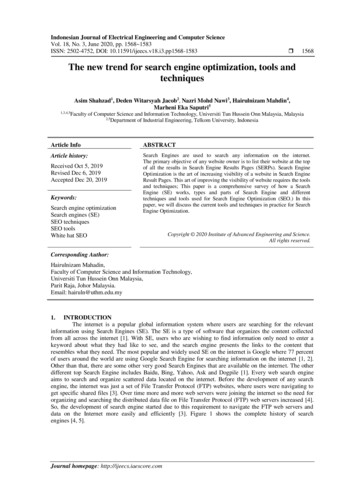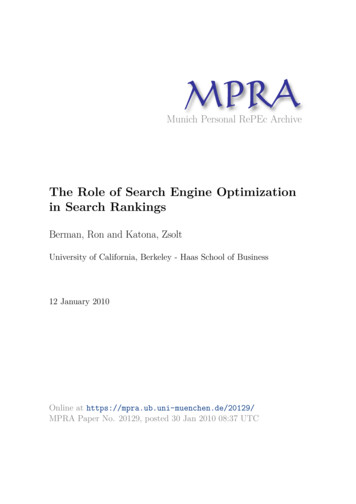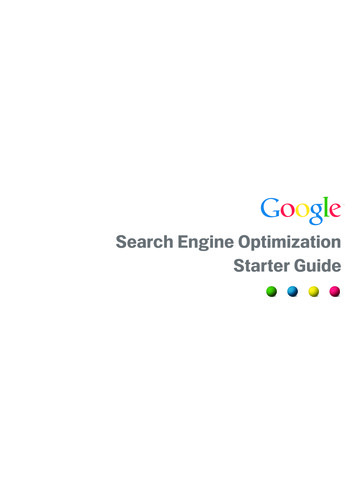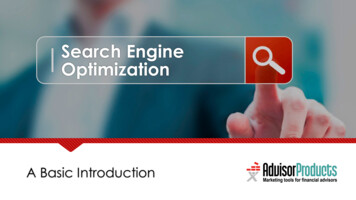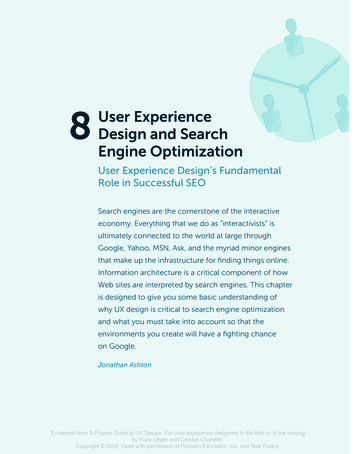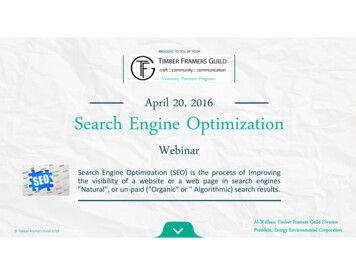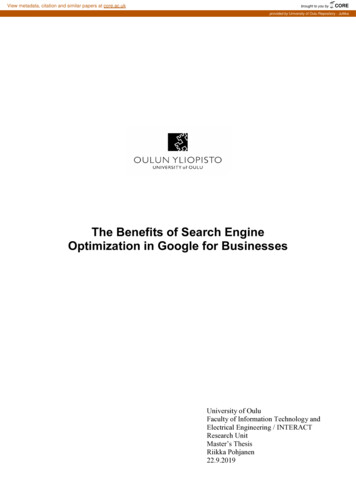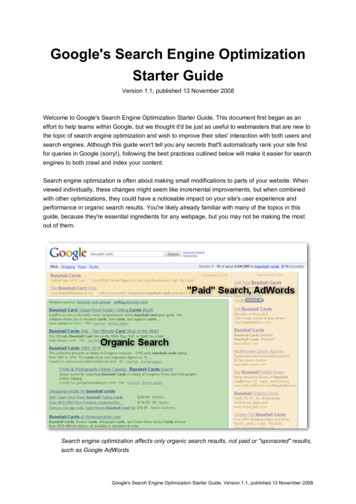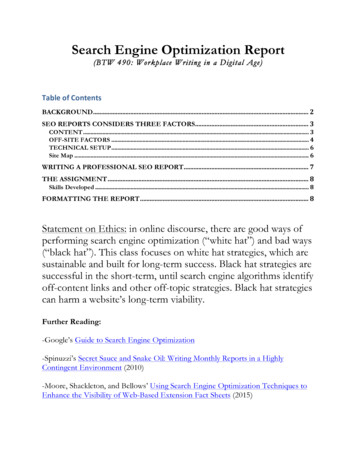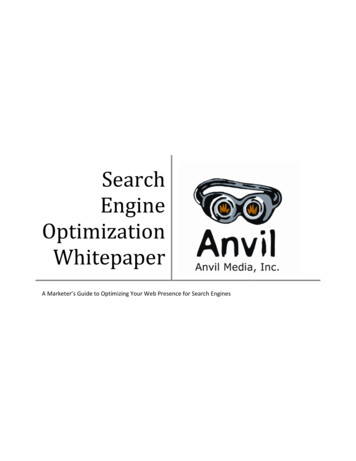
Transcription
SearchEngineOptimizationWhitepaperA Marketer’s Guide to Optimizing Your Web Presence for Search Engines
A Marketer’s Guide to Optimizing Your Web Content for Search EnginesTable of ContentsAbstract . 3Introduction . 4Search Engine Optimization. 4SEO vs. PPC . 5Why Optimize? .5-7Top Search Engines. 8How Search Engines Work .8-9Determine Relevancy: Keyword Location and Frequency . 9Assessing the SEO Friendliness of Your Site. 10Site Architecture .10-11On Page Factors.11-12Off Page Factors .12-13Optimization Beyond HTML .13-14Mobile Search.14-15Common Impediments to Effective SEO .15-16Developing Your Internal SEO Process: A Checklist . 16Conclusion . 17Appendix . 18 2009 Anvil Media, Inc.2www.anvilmediainc.com
A Marketer’s Guide to Optimizing Your Web Content for Search EnginesAbstractThis whitepaper addresses the fundamentals of search engine optimization including on pagefactors such as keyword use as well as off page factors such as link development. Optimizationtips are offered for everything from the coding, to the writing, to the design of your site as well astips on multimedia and mobile search. Skillfully employed, they can dramatically strengthen yoursearch engine ranking, and with it, hopefully, your bottom line. 2009 Anvil Media, Inc. All rights reserved. Anvil Media does not warrant, guarantee or makerepresentations concerning the contents of this document. All information is provided “AS-IS” withoutexpress or implied warranties of any kind. Anvil Media and the Anvil Media logo are trademarks of AnvilMedia, Inc. All other company, product and service names and brands are trademarks or registeredtrademarks of their respective owners. Whew. Glad to get that out of the way. 2009 Anvil Media, Inc.3www.anvilmediainc.com
A Marketer’s Guide to Optimizing Your Web Content for Search EnginesIntroductionAs a strategy, build it and they will come may work in Hollywood movies, but it is not an effectivebusiness strategy for a web site. The Internet can be a jungle, and it takes the right tools andtechniques to excavate the rich opportunities it can offer your business. Businesses thatleverage the right tools and techniques bolster their chances for success. Those that do not arerarely around long enough to matter.Just as with exploring any jungle, good directions can mean the difference between life anddeath on the web. Businesses must, therefore, make their sites as easy to find as possible. Thiswhitepaper is intended to help you do just that using the most critical tool of all – search engineoptimization (SEO).By optimizing the search engine viability of your site, you are putting your business on theInternet map. This is crucial. Because if search engines like Google, MSN and Yahoo! cannotfind you, it is unlikely your prospects will find you, either.Search Engine Optimization (SEO)SEO addresses the central question posed by all enterprising web site owners and operators:what do search engines look for to determine the relevance of that page in a given search? Theanswer, as it turns out, sounds rather simple: you must design, write, and code your site withthe keywords and phrases most likely to be used by your target audience in their searches. Thecore concepts of the SEO strategy can be boiled down to what we like to call The 3 C’s: content,code and credibility. Content: unique, valuable and filled with descriptive vocabulary that prospectivecustomers/clients are most likely using to describe your offerings and/or find relatedinformation with. Code: a clean code that will not detract the engines from finding your site’s content. At avery high level, this includes the type, placement and amount of code. Credibility: factors that help to build credibility include but are not limited to domain age,PageRank (a value assigned by Google and based a scale from 1 to 10 - gives siteowners a rudimentary idea of how authoritative Google views their content), and inboundlinks from relevant and credible sources.The ideal time to optimize your site for search engines is in the initial, planning stages – whenyou’re drawing up your site map and selecting a content management system (CMS). However,if your site is already up and running, you can still optimize it by implementing best practices,many of which are outlined in this document. 2009 Anvil Media, Inc.4www.anvilmediainc.com
A Marketer’s Guide to Optimizing Your Web Content for Search EnginesSEO vs. PPCPay-Per-Click (PPC) Listings are usually distinguished from editorial results to illustrate that theyare, in fact, ads. Such listings can be found above editorial links, at the bottom of editorialcontent, or in sidebars to the right of search engine results.OrganicPPCAlso called “pay for placement,” “pay for performance,” or “CPC listings” (cost per click), PPCrefers to paid ads that guarantee placement, though CPCs and PPCs only require payment ifsomeone clicks on their ads.In some cases, a site owner will pay to have his web pages included in a search engine’slistings, known as pay-for-inclusion (PFI). While this typically does not buy a bump in theranking, it does ensure that the pages will be listed more rapidly (within days vs. weeks with aspider-based search engine).Having a combination of organic and paid listings in search results, especially top-of-the-pagepaid listings, dramatically increases overall branding effectiveness for a site. Branding hasbecome equally important to the internet as in traditional marketing venues. Making your brandas visible as possible online is critical to high click through rates on both paid and organiclistings. (MarketingSherpa Search Marketing Benchmark Guide 2009)Why Optimize?Return on Investment (ROI): When done properly, SEO can be cheaper than any other onlinemarketing medium. Although up-front costs (whether hiring an agency or investing in thenecessary resources like a CMS) may seem overwhelming, SEO is a highly beneficial activityfor the long run.You may think of search as a “pull” form of marketing in that prospective users are activelyseeking the information or product described by their search query. Given this (and dependingon the query itself) searchers are already a much more valuable prospect than say, someonewatching a television show where an ad is “pushed” in front of them. 2009 Anvil Media, Inc.5www.anvilmediainc.com
A Marketer’s Guide to Optimizing Your Web Content for Search EnginesFurthermore, ROI can be tracked down to the very keyword that eventually translated into a saleor a desired conversion. Marketers can access comprehensive revenue data to facilitate budgetdecisions and impact their organization’s bottom line.While PPC is a valuable and effective method that can raise awareness, drive traffic to a newsite that hasn’t yet gained organic rankings and generate sales – increasing bids and expensivekeywords may not always be as justifiable as investing in an effective SEO strategy.SEO expenses diminish over time, enabling them to survive for years. They also have a betterchance of delivering return customers because they focus on what the customer is looking forrather than what the PPC-sponsoring company thinks the market wants.Appendix: Figure 1.0 – Long Term Benefits of Organic vs. Paid SearchCompetition: On average, organic listings make up 95% of clicks in search engines, while only5% of clicks are for paid advertisements. (MarketingSherpa Search Marketing BenchmarkGuide 2009). If your company is not optimizing site content to achieve the best possible rankingin those search results, you are missing important opportunities for your business. A recentstudy done by MarketingSherpa found that after optimizing a website for six months using SEOstandards you could receive up to a 110% increase in relevant traffic.Appendix: Figure 1.1 – Natural vs. Paid Search Clicks (All vs. Business Decision Makers) 2009 Anvil Media, Inc.6www.anvilmediainc.com
A Marketer’s Guide to Optimizing Your Web Content for Search EnginesA new study by Radar Research reports that fewer than 10% of Fortune 100 companies areeffectively using SEO for their sites. Such a situation promises great opportunities for thosecompanies, large and small, employing SEO.Appendix: Figure 1.2 – Increased amount advertisers and SEM agencies plan to spend on SEM in 2008Appendix: Figure 1.3 – Daily online activities of US internet users, April – May 2008Motivated Prospects: By researching and targeting strategic key phrases that appeal to yourtarget audiences, SEO puts you in front of precisely those people looking for what you offer. Asa result, CPL (cost per lead) numbers can be much lower for organic search engine rankingsthan other more traditional marketing methods. SEO is one of the few marketing strategieswhere your targeted audiences are actively engaged in the process of seeking information.Consider the following: 220 million Americans have Internet access at home and/or work and 73% went onlinein May 2008. (Nielson, May 2008)For every 1 in online sales, the Internet influenced 3.45 of in-store sales. (eMarketer,2007) 2009 Anvil Media, Inc.7www.anvilmediainc.com
A Marketer’s Guide to Optimizing Your Web Content for Search EnginesTop Search EnginesThere are several different search engines in existence today; but Google dominates the marketwith just under a 72% market share.Appendix: Figure 1.4 – Search Engine Market ShareAppendix: Figure 1.0Based on this information, Google’s guidelines and recommendations are taken very seriouslywithin the search industry. Although there are some exceptions and differences, best practicesfor Google are typically best practices for all engines.How Search Engines WorkSearch engines help people find information on the Internet that is relevant to the keywords orphrases they have used in their search. To do this, search engines rely on programs called“spiders,” “crawlers” or “robots.” How it works:The search engine sends out a spider to a particular web page. It reads the content found onthat page and then follows links to the other pages within the site to read those pages. Thisinformation is collected in an index, or catalog, with search engines indexing as much of yoursite as they can access.These indexes include most of the content that visitors see when viewing pages, as well aspieces of the hidden code used to build the pages. Search engines cannot spider all types ofcontent however, and sometimes encounter problems with certain kinds of graphical content,flash files, portable document format (PDF) files and dynamic content.Facilitating the indexing process is the first step to obtaining rankings. To ensure that all of awebsite’s optimized pages are ranking in the engines, both an HTML sitemap and XML sitemapshould be added to your site. 2009 Anvil Media, Inc.8www.anvilmediainc.com
A Marketer’s Guide to Optimizing Your Web Content for Search Engines An HTML sitemap should include links to all pages within your site. This not only helpssearch engines to locate all pages on the site, but improves usability as well by showingvisitors all available content. XML sitemaps are placed in the site and should be submitted to Google, Yahoo andMSN webmaster tool accounts. Once this is done, the search engines will spider andindex the pages accordingly. The frequency that a search engine re-indexes your sitecan be set in the XML sitemap file, more frequent updates are recommended for siteswith a lot of fresh content, while sites can be indexed less frequently if content tends tobe static. Google recommends only adding pages you would want to rank in searchresults in the XML sitemap, and consequently, because there are fewer total links,Google will index your site more frequently. (Official Google Webmaster Blog,10/15/2008)Each time a person searches on a keyword or phrase, the search engine consults the millions ofpages in its index to find matches. These matches are then ranked in order of relevancy. Sowhat determines relevancy?Determining Relevancy: Keyword Location & FrequencyTo optimize your content, you must start with your keywords and phrases. They are the linkbetween your site and search engines, therefore between you and your customers, so theymust be carefully selected.To determine ranking and relevancy, search engines analyze page elements and other factors,weighing each based on a chosen formula, or algorithm. Ranking algorithms rely heavily on thelocation of keywords and their frequency on the page. When keywords appear near the top of apage, such as in the HTML title tag, the headline or in the first few paragraphs of text, thosepages are typically assumed to be more relevant.Frequency is another key determinant surrounding how search engines establish relevancy. Asearch engine will analyze how often keywords appear in relation to other words on a page.Those with a higher frequency are characteristically deemed more relevant.When writing copy for a well optimized website, keep the 3P’s of copywriting in mind: Placement refers to putting keywords on the page as well as in the coding of the page. Prominence requires that you place your keywords near the top of the page as often aspossible. Proximity allows you to break up keyword phrases as long as all parts of that phraseremain relatively close to each other in the text. This allows your copy to be written witha natural sounding flow and does not look like you are trying to spam the search enginesby repeating keyword phrases on a page. As content remains a core concept of SEO itis critical that the content present on your site is well optimized and well written. 2009 Anvil Media, Inc.9www.anvilmediainc.com
A Marketer’s Guide to Optimizing Your Web Content for Search EnginesAssessing the SEO-friendliness of Your Site“SEO-friendly” refers to the factors that enable search engines to access, read, and rank webpages. These factors can be broken down into three categories: site architecture, on pagefactors and off page factors. The ability to effectively optimize all of the elements within thesecategories will impact how search engines read code, understand content relevance anddetermine credibility.Site ArchitectureURLs: search engines look for descriptive keywords in URLs in order to aid in the process ofdetermining relevance and rankings. This is important not only when choosing a site domain,but also when developing a site hierarchy and folder names. Using descriptive, keyword-richURLs benefit not only search rankings, but has proven to increase organic CTR as well.Dynamic pages that require URL-based parameters, (i.e. a “?” or equivalent in the URL) areable to be read and indexed by search engines but can result in lower click through rates.Historically, search engines have had difficulties indexing dynamic URLs however this is nolonger the issue that it used to be. As a result, webmasters often rewrite dynamic URLs toappear as static although this is no longer necessary.Tip: When using a keyword phrase in your URL, separate words with a dash (as opposed tounderscores or hyphens) for the best search engine comprehension.Directory Structure: a well organized directory structure improves usability as a visitor hasclear paths both into deep content as well as back to higher pages within the site’s hierarchy.Tip: Place relevant pages as high in the directory structure as possible. A good CMS will permityou to control your menu items and directory structure to place the most relevant pages at thetop. It will also have a flat file structure that allows spiders to index the whole directory. Look fora CMS that automatically generates a site map (HTML and XML ideally).Domains and Sub-domains: Search engines look for keywords in domain names to furtherassist them in the process of determining relevancy for search queries. A simple, easy toremember domain is beneficial for branding purposes and sharing between prospectivecustomers. Lengthy domains, or domains made up of abbreviations and acronyms can bedifficult both from a usability perspective and are less desirable for SEO purposes.Search engines treat subdomains as separate sites. While it is possible to obtain additionalrankings with optimized subdomains, the major search engines have said they will no longerallow subdomains to rank for an additional two search results. These changes have not yetbeen implemented, but should be taken into consideration when planning site structure andorganization of your site’s content.Tip: Include keywords in main domain as well as sub-domains.Navigation: all site navigation elements in text format impact search engine visibility. Usingkeywords in the site’s navigation will provide another opportunity for keyword usage on a pageand help search engines understand relationships between pages on your site. Utilizingbreadcrumb navigation (i.e. Home Products Widget) can improve both usability and visibility.If using dynamic or image-based navigation, it’s essential to complement with HTML textnavigation (usually in the footer). 2009 Anvil Media, Inc.10www.anvilmediainc.com
A Marketer’s Guide to Optimizing Your Web Content for Search EnginesTip: Try to avoid CMS platforms that utilize Javascript or AJAX for navigation, as dynamicnavigation is not easily indexed by spiders.On Page FactorsTitle Tags: one of the most important pieces of the SEO puzzle. As most search enginesassume that the title describes the content on its page, they weigh it more heavily than otherareas of keyword placement when determining relevancy. Though the titles are not seen on theactual page itself, they do show up at the top of the browser window and in the viewer’s list offavorites (or as bookmarks). More importantly, this is the title viewers see in their search results.Tip: Search engine results typically cut off title tags after 70 characters, making it difficult forusers to fully understand your site’s content. Keywords should be placed near the beginning toemphasize importance and ensure critical information isn’t cut off in the search results. If yoursite has other information in between the head tags (such as JavaScript code), place the titleand META tags before this other data so that it is placed “higher” on the page and will be readby the search engines first.META Description Tags: search engines will often use the META description tag as thedescription provided in the search results. Search results may also include snippets of contentfrom the page itself based on a user’s query and the relevancy determined by the searchengine. META tags are not weighted as heavily by search engines as they once were; in fact,some search engines do not index them at all anymore. Nevertheless, they remain an importantelement for boosting rankings and click-through rates from the search engine results page(SERP).Tip: Be sure to write compelling and descriptive snippets that will increase your organic clickthrough rate (CTR). Typically, descriptions should not exceed the 150 character limit and everypage on the site should contain a unique description that represents the page’s content.Title TagMETADescriptionMETA Keywords: while not as important to search engines rankings as they once were, it isstill a best practice to include unique keywords in the source code of each page. Like title tagsand META descriptions, use only keywords relevant to the content on the page, not the entirekeyword set you want your site to rank for. Typically no more than 15 META keywords shouldbe used per page.Tip: use the META keyword tag to include common misspellings for products and services. 2009 Anvil Media, Inc.11www.anvilmediainc.com
A Marketer’s Guide to Optimizing Your Web Content for Search EnginesHeader Tags: header tags, or H tags, are an HTML element used to create emphasis forspecific content, like headlines or subheads at the top of a page. Search engines placeadditional weight on keywords that appear in header tags. H1 tags provide the mostemphasis on a page and should only be used one time per page. Other H tags of lowervalues can be used multiple times on a page.Tip: Make sure your CMS auto-generates header tags, as it will ensure proper optimization ofsite code.Body Copy and Emphasized Text: integrate targeted keywords throughout the body copy of agiven page. Remember the 3 P’s of keyword placement to help guide you through this process.Furthermore, search engines often consider text in larger fonts, bold, or italics to be especiallyrelevant. Where relevant, use this emphasized text (such as sub-headers and bolded imagecaptions) to help meet optimization goals.Tip: Use font size or heading tags for titles, subtitles, or other important text. Within body text,emphasize keywords by bolding or italicizing them.ALT Tags: provide a text description of a graphic. Search engines cannot read words that are inthe form of a graphic such as a logo or site navigation menu. Some search engines however,will read the ALT tags that correspond with these images.Tip: Place keywords in the beginning of your ALT tag, and keep tags brief. Do not add ALT tagsto images that are purely visual, such as backgrounds.Hyperlinks: hyperlinks are “clickable” pieces of text that connect a viewer to another page orweb site. Keywords within hyperlinks (also known as ‘anchor text’) are an especially importantarea of placement in terms of SEO.Tip: Within body copy (and as relevant) link to other pages on the site with targeted keywordswithin the hyperlink. Note that by optimizing anchor text links you are telling the search enginethat the page that is linked to is the most relevant for the keywords within the anchor text.Off Page FactorsInbound LinksArguably one of the most critical factors surrounding search engine optimization is the inboundlinks that point to your site. Search engines not only find content by following links, they alsodetermine relevancy and credibility by looking at the quantity, quality and topical relevance ofsites that are linking to your content. Keep in mind that link quality, i.e., links from popular, highlytrafficked sites, is always more important than link quantity.Indicators of a Quality Inbound Link Optimized anchor text (descriptive keywords within hyperlink)Trusted and credible site (.org and .gov are typically “trusted” for example)Industry/topical relevance (think of this as your link “neighborhood”) 2009 Anvil Media, Inc.12www.anvilmediainc.com
A Marketer’s Guide to Optimizing Your Web Content for Search EnginesAppendix: Figure 1.5 – Link Building MatrixNo two search engines determine relevancy in precisely the same manner. Historically, Googlehas placed more emphasis on inbound link quality than search engines such as Yahoo andMSN. The result is that the indexes of competing search engines differ, meaning their searchresults may vary.Human-Powered Directories:Unlike a spider-based search engine, a human-powered directory, such as the Open Directory[dmoz.org] or Yahoo! are created by people as opposed to a software program. Its catalog iscomprised of editorial reviews of sites and short site descriptions submitted by site operators(and often edited by site reviewers).Directories rarely drive a substantial number of visits to a site, and are being used lessfrequently as supplemental result sources for the main search engines. Google no longerdeems submitting to directories as a necessity for achieving a high ranking in search results.Consequently, submitting your site to any of these general directories should be consideredoptional. However, finding industry specific directories such as MacRae’s blue book orThomasNet for industrial sites are more successful at driving qualified visitors.Optimization beyond HTMLWith the addition of social media outlets such as YouTube, Facebook and Flickr, it’s becomingincreasingly popular for websites to create their own multimedia services including audio, video,and image based content. Additionally, PDF content can often index and rank well, so it’simportant not to leave this content out. Overall, optimizing multimedia content is similar tooptimizing any other content on a site, with a few slight differences. The following includes bestpractices surrounding how to best prepare multimedia content for search engines. 2009 Anvil Media, Inc.13www.anvilmediainc.com
A Marketer’s Guide to Optimizing Your Web Content for Search EnginesAudio/Video Offer audio and video content in as many formats as possible. Some search enginesonly accept certain file types, so being prepared for all formats is necessary. Implement Title and META tags. Use targeted keywords in social media “tags” where applicable. Use targeted keywords in the filename and URL. Use targeted keywords in the link text for the file. Optimize the video's presentation page using standard SEO techniques. Make the audio and video content available in text format. Create RSS feeds for distribution and promotion. Add call-to-action buttons to submit content to Digg, Del.icio.us, StumbleUpon, etc. Create a video thumbnail for display in search results for branding purposes and toentice users to click through.Images Use quality images with high resolution. Use targeted keywords that are related to the image. Store images in .jpg format. Include links with anchor text that is targeting keywords in the photo captions and pointthose back to relevant pages on the site. Alternatively, point links from related webpages on the web site back to the photo pages. Use less restrictive licensing so others can use the photos, which will encourage linksback to the web site.PDF Documents Consider offering an HTML version of the PDFs; include these pages in your XMLsitemap. Use descriptive keywords to name the PDF. Find a CMS that can automatically convert HTML to PDF at the prospects’ request,enabling you to avoid serving up two versions of the same information.Mobile SearchMobile search is rapidly growing and is expected to eventually surpass standard search in termsof volume. This has become especially true since the release of the Apple iPhone. Now morethan ever, people are using mobile technology to connect to the web. While mobile usage israpidly growing however, many websites are having trouble keeping up. Websites must now beproperly optimized for mobile device screens. The following includes a handful of best practicessurrounding mobile friendly websites. Users should be able to navigate through the site by clicking on links, not by typing intext. Mobile devices can offer limited text capabilities and most users prefer to use textsparingly. Use short and sensible URLs. Links should be large font sizes and easily accessible from any mobile device. Somedevices require the use of a stylus to navigate while others allow the use of a finger.Links should not open a new page when clicked. Each page should have clear and extensive navigational links, both at the top and thebottom of the page to save on scrolling. Don’t build mobile sites out of Javascript or Flash. Most mobile devices aren’t compatiblewith these formats. Instead, use CSS. 2009 Anvil Media, Inc.14www.anvilmediainc.com
A Marketer’s Guide to Optimizing Your Web Content for Search Engines Lay out your page linearly. All mobile devices have different resolutions and aspectratios. To combat this, keep the most important content at the top of the page.Ensure a strong call to action towards the top of the page to encourage visitors tocomplete a desired action.Common Impediments to Effective SEONot all content is visible to search engines. As sophisticated as they are, there are still severalroadblocks many site owners and search engine specialists encounter surrounding SEO.Content in this format is not ideal but fortunately there are still some workarounds that can beemployed for improved search visibility and performance. Furthermore, it is recommended toavoid any spam techniques as these will typically hinder your ability to achieve optimal visibility.Excessive and Improper Flash UseFlash is a useful Adobe vector graphics animation tool that creates small file sizes. Used in theri
This whitepaper addresses the fundamentals of search engine optimization including on page factors such as keyword use as well as off page factors such as link development. Optimization . flash files, portable document format (PDF) files and dynamic content. Facilitating the indexing process is the first step to obtaining rankings. To ensure .
